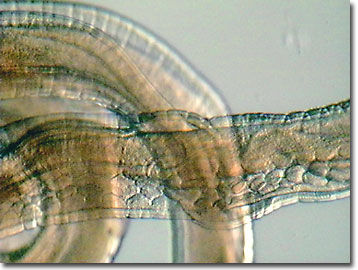Oblique Digital Image Gallery
Trichuris Whipworms
Whipworms, members of the rather large genus Trichuris, are intestinal parasites having about 60 species that infect mammalian hosts. Two common species, the human whipworm (T. trichiura) and canine whipworm (T. vulpis) display a relatively high degree of host specificity, with canine whipworms only rarely occurring in humans.

The common name whipworm is based on the characteristic shape of adult parasitic roundworms or nematodes. Adult whipworms live in the host's large intestine with their very thin anterior ends embedded in the intestinal lining. These intestinal parasites feed on tissue secretions instead of blood. Amazingly fertile, each female can produce more than 10,000 eggs per day, and an individual worm may live several years in its host. The parasite's eggs are passed in the host's feces and they are not infective for about the first three weeks. Infective eggs, eaten with soil by the appropriate host, first hatch in the small intestine, and then the juvenile worms migrate to the large intestine, the site of sexual maturation. The entire life cycle takes about three months. Problems with human whipworm infestations are prevalent in tropical Asia and to a lesser extent in Africa and South America. In the Unites States, approximately 2.2 million people are infected, primarily from the rural Southeast. Treatment is with mebendazole, a pharmaceutical that blocks glucose uptake in the helminths, and albendazole, which decreases whipworm ATP production.
Because whipworms live for an extended period of time, and a person or dog can be constantly re-infected, a heavy worm biomass can develop within a host. Human symptoms of whipworm infestation include diarrhea, anemia, and in serious cases with children, mental and physical retardation. Male whipworms are significantly smaller than the egg-bearing females. The thicker, posterior end of a male Trichuris features an evertable spicule, while the female has a bluntly rounded posterior end.
Contributing Authors
Cynthia D. Kelly, Thomas J. Fellers and Michael W. Davidson - National High Magnetic Field Laboratory, 1800 East Paul Dirac Dr., The Florida State University, Tallahassee, Florida, 32310.
BACK TO THE OBLIQUE IMAGE GALLERY
BACK TO THE DIGITAL IMAGE GALLERIES
Questions or comments? Send us an email.
© 1995-2025 by Michael W. Davidson and The Florida State University. All Rights Reserved. No images, graphics, software, scripts, or applets may be reproduced or used in any manner without permission from the copyright holders. Use of this website means you agree to all of the Legal Terms and Conditions set forth by the owners.
This website is maintained by our
Graphics & Web Programming Team
in collaboration with Optical Microscopy at the
National High Magnetic Field Laboratory.
Last Modification Friday, Nov 13, 2015 at 01:19 PM
Access Count Since September 17, 2002: 17043
Visit the website of our partner in introductory microscopy education:
|
|
